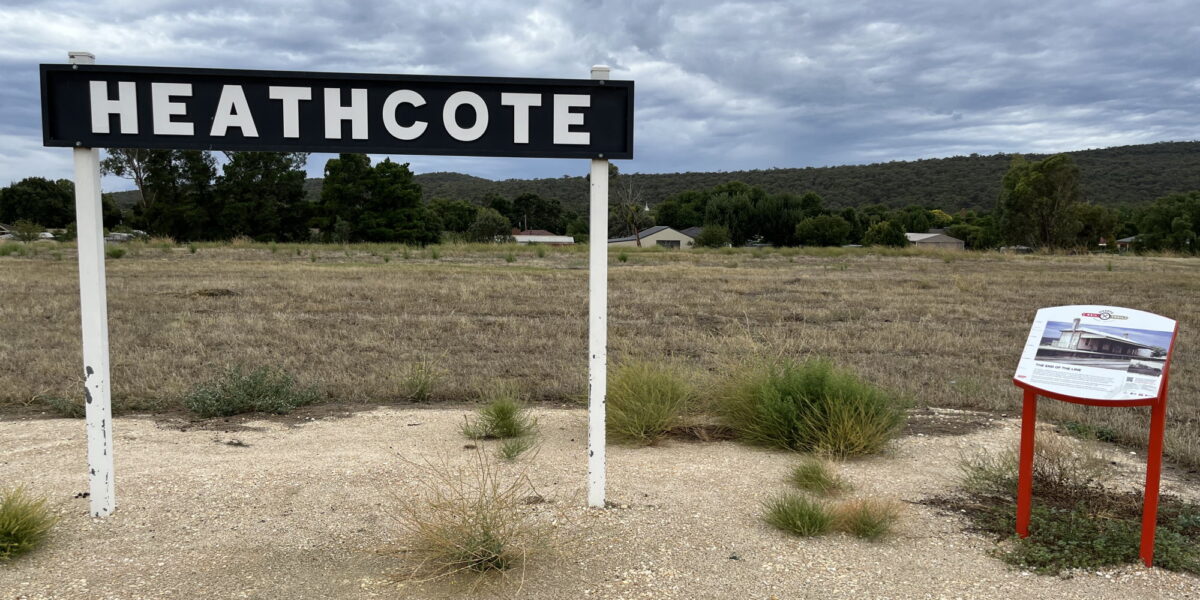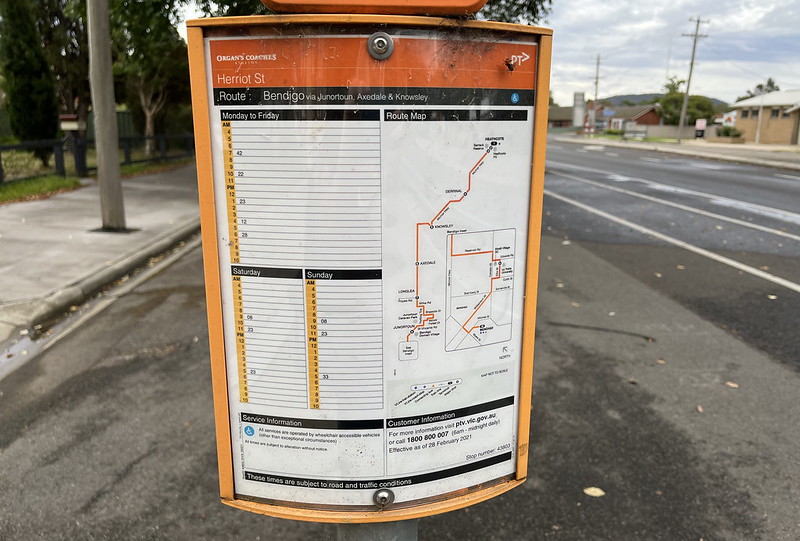We’ve got family in Heathcote, so I visit there a few times a year. The town is about 110 kilometres north of Melbourne and has a population of just under 3000.
So what are the current and past public transport options in a town like this?
Have you ever noticed how the main freeways out of Melbourne parallel the main railway lines? Heathcote is between the Hume/Seymour-Albury line and the Calder/Bendigo line.
The town was served by a branch railway line which opened from Bendigo in 1888, and through to connect with the main northeast line at Kilmore Junction (later renamed to Heathcote Junction) in 1889.
Being a branch line, the Heathcote line never seems to have had very many trains. The 1928 timetable shows generally just 1 or 2 trains per day in each direction served the station, and it’s a similar story in the 1954 timetable.
The line closed in stages between 1958 and 1968. More recently a bike rail trail was opened along the old route to Bendigo, and there’s a restored sign where the station once stood – a few hundred metres behind the main street.
And the public transport nowadays?
There’s a Heathcote to Bendigo bus which runs 5 times a day on weekdays, and 3 times a day on weekends. The bus has no route number, but appears to have Myki ticketing.
The route is pretty direct along the highway, apart from a small diversion via the La Trobe Uni campus in Bendigo, and another that appears to be to serve a housing estate in Junortoun on the eastern side of Bendigo.
The bus takes about an hour from Heathcote to Bendigo station, which is faster than the old train, which took about 90 minutes.
The town’s main link being to Bendigo makes sense as it’s the biggest nearby city (population about 101,000).
Apart from the bus to Bendigo, there are also several V/Line coach routes serving Heathcote:
- Melbourne via Bendigo to Barham – once a day
- Melbourne via Shepparton to Barmah – once a day
- Melbourne via Echuca to Deniliquin – generally once a day, but twice a day on Mondays, Fridays and Saturdays
Yeah, Barham and Barmah. That’s not confusing at all. Don’t get on the wrong coach!
The coaches to Melbourne take about 2 hours, and effectively there are only two per day as the Barham and Barmah coaches run in parallel to serve slightly different towns between Melbourne and Heathcote, with interchange at Heathcote for final destinations.
Given how infrequent the coaches are, a journey planner may suggest you travel on bus and train via Bendigo – more frequent, but taking about 3 hours.
Back in 1928 it was a similar story: direct and via Bendigo options were shown in the timetable. The direct daily train from Heathcote to Melbourne took around 3.5 hours, or travelling via Bendigo took 5+ hours depending on connections.
Let’s face it, public transport back then on branch lines like this was not terrific. Most people used it because they didn’t have a choice.
While Heathcote no longer has a train service, you could easily argue that public transport services to the town are now better than they’ve ever been: faster and with more services.
Is it enough to compete with cars? Definitely not, given multiple driving routes from Melbourne taking around 90 minutes, generally without much in the way of delays.
Public transport prior to cars didn’t have much in the way of competition. Now it needs to compete with cars, so it absolutely needs to be better than ever before.
That can be a difficult task in small regional towns, especially those off the railway network, but better buses providing direct connections to fast frequent trains can make help make more trips competitive with driving.
Related: the Climate Council yesterday published a poll showing Australians overwhelmingly want more investment in public transport and active transport.





6 replies on “Heading to Heathcote”
My mate lives in Heathcote and he drives to Seymour to catch the train into Melbourne (he has a seniors card) as it’s the most practical for him. But it’s a shame that he needs to drive to access the “good public transport”.
Regarding the poll showing Australians overwhelmingly want more investment by government in public transport and active transport. Of course they do. Everyone wants someone else to pay for what they want. It would be remarkable if a study found people wanted to pay more out of their own pockets for anything.
Would it be worth editing a copy of the V/Line coach map to show how many weekly services run on each route, and cross-reference with annual patronage figures if those are available? People often talk about restoring the trains between Geelong and Ballarat, a route that has 10 weekly return services, but the Heathcote-Bendigo link has 31 weekly return services plus the 14 weekly return services between Heathcote and Barmah via either Elmore or Shepparton. If those numbers reflect patronage in any meaningful way, some interesting conclusions could be drawn…
So a question, why doesn’t more of the regional network feed passengers into the rail network?
Is it really a necessity to go all the way from Barham to SXS as a single seat bus journey?
How come it doesn’t just terminate at Bendigo?
Then for places like Heathcote, you might just run a bus Bendigo to Wallan rather than a mix of V line and local bus.
@Gavin, I suspect the answer is that those coaches also serve intermediate destinations such as Romsey and Kilmore etc.
I notice the Barmah coach from Melbourne does connect with the train at Shepparton (doing train+coach saves you about 45-90 minutes depending on the trip) and there is also an additional coach on weekdays that only runs from Shepp to Barmah.
In contrast the Echuca train does not appear to connect with the Deniliquin coach (though many of the services to Echuca are actually coaches from Murchison East or Bendigo)
the station sign keming bothers me, for some reason …
Heathcote is part of the City of Greater Bendigo so it makes sense to have the main connections to Bendigo. But that’s the wrong way for a Melbourne connection, which should be via the Seymour line – however there are no real options to do that and the coach via Kilmore doesn’t interact with the rail line. I see that the coach via Lancefield gives a Melbourne Airport connection though!
Interesting the route that the Barham and coach takes to get to Heathcote. It heads pretty directly to Shepparton via Nathalia, but Shepparton to Heathcote is a bit circuitous (starts heading in the Echuca direction to get to Kyabram before heading south) and surely there are better connectivity options.
I wonder if this set of three coaches running direct to Melbourne (Barham, Deniliquin and Barmah) that effectively funnel via Heathcote are an historical anomaly that haven’t been effectively integrated into the overall regional network.